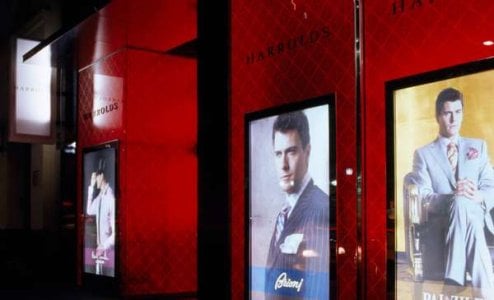Luxury fashion empire Harrolds crumbles with millions in debt
By
Danielle F.
- Replies 100
The world of high fashion is often seen as a realm of timeless elegance and enduring success.
Yet, even the most prestigious brands are not immune to the harsh realities of the retail industry.
In a stunning turn of events, an iconic Australian luxury fashion retailer has collapsed and left a trail of debt and uncertainty.
Harrolds, a name synonymous with opulence and style, has been a fixture in the Australian fashion landscape for nearly four decades.
Founded in 1985, the family-owned business opened its first store in Melbourne and quickly became the home for brands such as Tom Ford, Saint Laurent, Balmain, and Burberry.
Harrolds carved out a niche as Australia's only privately owned luxury department store, with additional stores in Sydney and the Gold Coast.
In an effort to adapt to the changing retail environment, Harrolds expanded its reach by launching an online store in 2020.
The online store boasted a collection from over 100 of the world's finest designer brands.
Despite its rich history, Harrolds has been quietly placed into liquidation earlier this month.
Liquidators from SMB Advisory revealed Harrolds’ staggering debt of more than $16 million owed to almost 90 creditors.
The list included outstanding debts to Victoria Beckham's company, two Tom Ford subsidiaries, American designer Thom Browne, Versace, and Stella McCartney, among others.
Harrolds' Managing Director, Ross Poulakis, expressed 'deep regret' over the decision.
'Despite our best efforts to adapt to the evolving economic environment, a combination of reduced luxury spending, decreased foot traffic, unprecedentedly high levels of CBD office vacancies and extremely unfavourable government policies has significantly impacted our ability to sustain operations,' Mr Poulakis shared in a statement.
'Unfortunately, the retail sector in Australia has been hit hard. Like many other retailers before us in this period, we have had to close our doors.'
The impact of Harrolds' downfall extended beyond the fashion labels.
Harrolds also owed their employees more than $190,000 in entitlements.
Various designers and luxury brands, including Feng Chen Wang, Mach & Mach, and Raffaele Caruso, were also left with unpaid bills.
The retailer also owed $2.3 million to one of its major creditors, The Australian Taxation Office (ATO).
Harrolds' closure marked the end of an era for luxury fashion in Australia. It also raised questions about the future of luxury retail in The Land Down Under.
For former employees and creditors, the path forward is uncertain.
SMB Advisory encouraged everyone affected by the liquidation to come forward and lodge claims.
As we witness the fall of Harrolds, it's a stark reminder that brands—no matter how luxurious or well-established—are not guaranteed survival in the volatile world of retail.

Have you shopped at Harrolds before? What do you think this means for the future of luxury shopping in Australia? Join the conversation and share your thoughts with us in the comments section below.
Yet, even the most prestigious brands are not immune to the harsh realities of the retail industry.
In a stunning turn of events, an iconic Australian luxury fashion retailer has collapsed and left a trail of debt and uncertainty.
Harrolds, a name synonymous with opulence and style, has been a fixture in the Australian fashion landscape for nearly four decades.
Founded in 1985, the family-owned business opened its first store in Melbourne and quickly became the home for brands such as Tom Ford, Saint Laurent, Balmain, and Burberry.
Harrolds carved out a niche as Australia's only privately owned luxury department store, with additional stores in Sydney and the Gold Coast.
In an effort to adapt to the changing retail environment, Harrolds expanded its reach by launching an online store in 2020.
The online store boasted a collection from over 100 of the world's finest designer brands.
Despite its rich history, Harrolds has been quietly placed into liquidation earlier this month.
Liquidators from SMB Advisory revealed Harrolds’ staggering debt of more than $16 million owed to almost 90 creditors.
The list included outstanding debts to Victoria Beckham's company, two Tom Ford subsidiaries, American designer Thom Browne, Versace, and Stella McCartney, among others.
Harrolds' Managing Director, Ross Poulakis, expressed 'deep regret' over the decision.
'Despite our best efforts to adapt to the evolving economic environment, a combination of reduced luxury spending, decreased foot traffic, unprecedentedly high levels of CBD office vacancies and extremely unfavourable government policies has significantly impacted our ability to sustain operations,' Mr Poulakis shared in a statement.
'Unfortunately, the retail sector in Australia has been hit hard. Like many other retailers before us in this period, we have had to close our doors.'
The impact of Harrolds' downfall extended beyond the fashion labels.
Harrolds also owed their employees more than $190,000 in entitlements.
Various designers and luxury brands, including Feng Chen Wang, Mach & Mach, and Raffaele Caruso, were also left with unpaid bills.
The retailer also owed $2.3 million to one of its major creditors, The Australian Taxation Office (ATO).
Harrolds' closure marked the end of an era for luxury fashion in Australia. It also raised questions about the future of luxury retail in The Land Down Under.
For former employees and creditors, the path forward is uncertain.
SMB Advisory encouraged everyone affected by the liquidation to come forward and lodge claims.
As we witness the fall of Harrolds, it's a stark reminder that brands—no matter how luxurious or well-established—are not guaranteed survival in the volatile world of retail.
Key Takeaways
- Australian luxury fashion retailer Harrolds recently went into liquidation and owed $16 million to multiple creditors.
- Harrolds, founded in 1985, was Australia's only privately owned luxury department store and had outlets in Melbourne, Sydney, and the Gold Coast.
- The company accrued debt with a number of famous design houses, including Victoria Beckham, Tom Ford, Thom Browne, Versace, and Stella McCartney, among others.
- The liquidation also affected employees and nearly 90 creditors, including the Australian Taxation Office, to which the company owed over $2.3 million.








